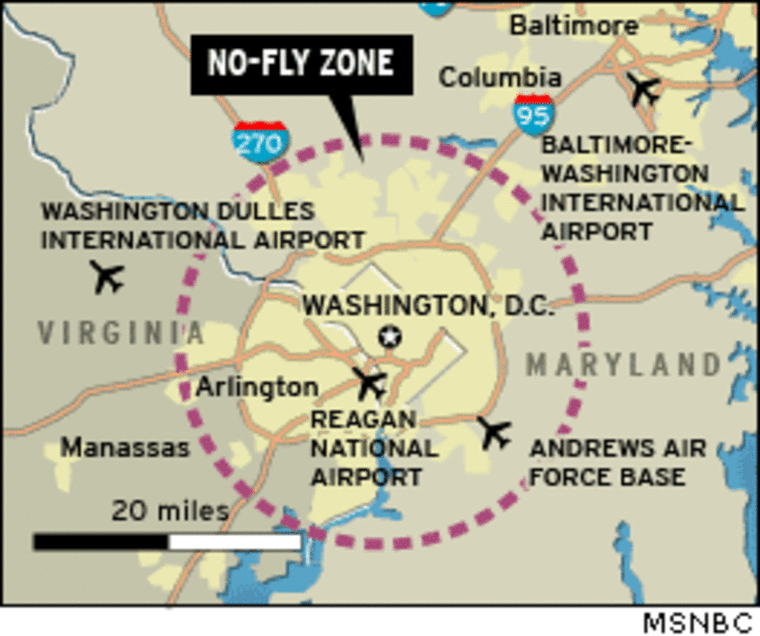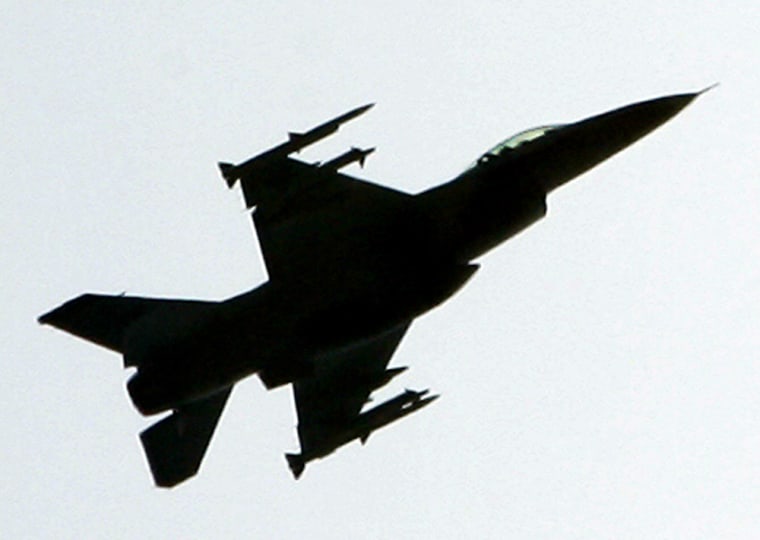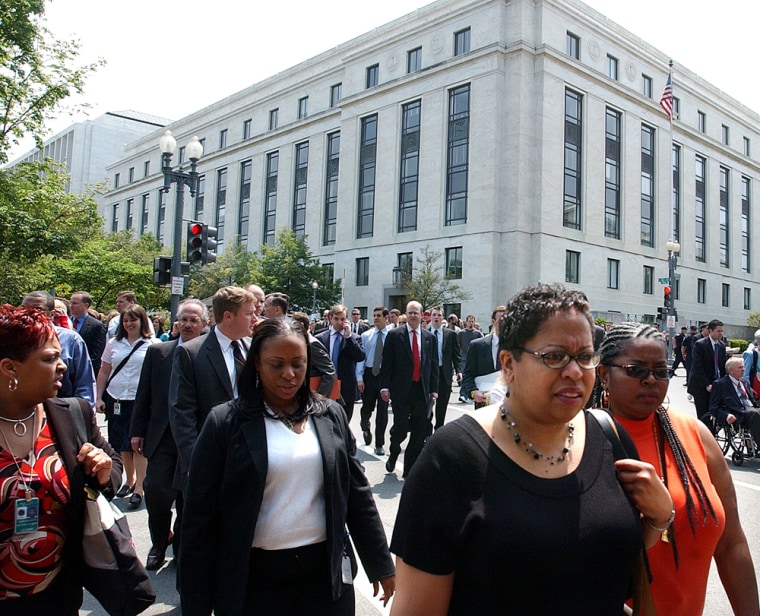As Washington settled down from Wednesday’s red-alert panic over a small plane that strayed into restricted airspace, the Beltway buzz on Thursday was likely to be all about why neither President Bush nor city officials were informed of the incident until it was over.
As workers, visitors and others — including the first lady and vice president — streamed frantically from the White House and fighter jets scrambled to intercept the Cessna, the Secret Service decided not to tell Bush, who was riding his bike at Patuxent Wildlife Research Center in Maryland.
City officials also were unaware of the incident until after the "all clear" was sounded, Mayor Anthony Williams said.
“Critical and potentially life-or-death information about threats facing district residents needs to be shared immediately — not five, 10 or 15 minutes after the fact,” Williams said. “I am concerned about the apparent delay in alerting key decision-makers in the city.”
Meanwhile, the Secret Service told NBC News that it was satisfied that the light plane's incursion was accidental. The two men aboard the Cessna were released after hours of questioning. A search of the plane found “nothing threatening” on board, an official told NBC’s Pete Williams.
Secret Service and Justice Department officials said no criminal charges are contemplated because there was no evidence of any criminal intent.

They pointed out, however, that both men still face administrative punishment from aviation authorities, which could include revocation of their pilot's licenses.
The White House said the Secret Service held off informing the president because he was not in danger and White House spokesman Scott McClellan said Bush was satisfied with how the situation was handled.
Half-hour into bike ride
Bush was about a half-an-hour into his ride at the Patuxent Wildlife Research Center in Maryland when the airplane came near the White House, sending the Secret Service scrambling to evacuate Vice President Dick Cheney and move First Lady Laura Bush to a secure location.
McClellan said the president’s Secret Service detail was informed about the plane at about 11:59 a.m., when the decision was made to raise the threat level at the White House to “yellow.”
Fighter planes were immediately scrambled to intercept the plane, and the threat level at the White House was raised all the way to “red” before the “all clear” was given at 12:14 p.m.
McClellan said Bush was informed about the incident around 12:50 p.m. at the end of his ride. He left the reserve around 12:57 p.m. and returned to the White House at around 1:30 p.m., well after the security scare had ended.
“The president was never in danger and the protocols in place after Sept. 11 were followed,” McClellan said. “The president has a tremendous amount of trust in his security detail and they were being kept apprised of the situation as it developed.”
Bush had left the White House at about 11:03 a.m. and had arrived at Patuxent for the bike ride at 11:34 a.m.
“Given such circumstances and the fact that the plane turned away from the White House, the decision was made to inform the president upon conclusion of his bike ride,” McClellan said.
McClellan later added, “there is always a review of the response to a situation of this nature.”
Officials to NBC: Shootdown never an option
U.S. military officials told NBC News that since the Cessna exhibited no hostile intent, there was no order given to the F-16 pilots to shoot it down.
The officials explained that, under strict rules of engagement, there is no situation under which the pilots would be given “authorization” to shoot down a plane, a scenario that would give pilots some discretion. According to the officials Air Force pilots in these cases are either ordered to shoot down the plane or not, and in this case they were not.

Military officials said when the F-16s dropped their flares, “it got their attention” and the plane immediately changed course away from the capital.
The aircraft later landed, and two men who reportedly were flying to a North Carolina air show were taken into custody. “This appears to be errant pilots,” Capitol police Chief Terrance Gainer told reporters hours before the Secret Service confirmed his suspicion.
The plane is registered to Vintage Aero Club in Smoketown, Pa. It was scheduled to be flown Wednesday by Jim Sheaffer of Lititz, Pa., and student pilot Troy Martin of Akron, Pa., to an air show in Lumberton, N.C.
Martin’s wife, Jill, said the two men left late Wednesday morning for Lumberton. “Troy was discussing with me last night after they made their flight plans all about the no-fly zones and how they were going to avoid them. He said they were going to fly between two different restricted areas,” she said.
‘You've got one minute’
When the plane was detected, capital police began quickly evacuating people.
“You've got one minute!” one officer at the Capitol yelled to a group including NBC correspondent Chip Reid. A few minutes later, after hundreds of people who had been in the Capitol fled to a park two blocks away, officials gave the "all clear" signal.
But during the brief evacuation, military jets scrambled over the area as people ran down streets. A motorcade stormed out of a side street next to the White House, NBC correspondent Norah O'Donnell reported from a cell phone as she evacuated.
The incident sparked a flurry of emergency activity throughout the capital, which was targeted on Sept. 11, 2001, and has been under a heightened state of alert since then.
Officers also rushed through the Supreme Court building and told staff to get into the basement. At the Treasury Department, people were moved across the street.
At the Capitol, several lawmakers said they fled after being told that a plane was just several minutes away.
The Cessna later landed at a small airport in Frederick, Md., where officials said the pilot reported his radio was not working.
Police said the club had not authorized the pilot to use the Cessna.
False alarms have happened before. Two weeks ago an evacuation was ordered when a radar hit suggested a plane had entered the area. The hit turned out to be clouds.
In that evacuation, Bush and Cheney were escorted to a bunker under the White House.
‘This is not a drill’
At the Capitol Wednesday, armed security officers raced through the building shouting for people to leave. “This is not a drill,” guards yelled as they moved people away from the building.
Sen. Richard Shelby, R-Ala., was on the Senate floor when police told him they needed to evacuate. “They said get out of here, so I ran. There’s no joking about this kind of stuff,” Shelby said.
House Speaker Dennis Hastert was on the House floor talking to members when the evacuation siren went off. He left quickly with his security detail.
Two large black armored SUVs often used by House and Senate leaders sped away from the Capitol.
“People were surprised. I was surprised,” said Rep. Bob Ney, R-Ohio, who was on the House floor.
“There was so much commotion in the gallery. People were yelling in the gallery. We thought something had happened in the gallery, and then the alarm came to evacuate.”
Order sent by pagers
Sarah Little, an aide to Sen. Pat Roberts, R-Kan., said the order to evacuate came over the special pager devices that every congressional office has. “They said ... there is an imminent aircraft threat,” she said.
Washington’s Reagan National Airport has been closed to general aviation since the Sept. 11 attacks. In the 3½ years since then, hundreds of small planes have flown within the restricted airspace around the capital — a 15¾-mile radius around the Washington Monument.
However, it’s rare for fighter jets to be scrambled.
